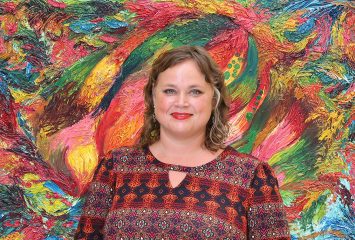Using Art to Treat Illness and Trauma
Amanda Allison and her students at TCU earned acclaim for designing therapeutic art programs.
Using Art to Treat Illness and Trauma
Amanda Allison and her students at TCU earned acclaim for designing therapeutic art programs.
As a first-year elementary school art teacher in Shreveport, Louisiana, Amanda Allison struggled to connect with her students who had disabilities. But that ongoing challenge shaped her professional journey.

Amanda Allison works with a student at Fort Worth’s International Newcomers Academy, a school for recent immigrants. Photo by Carolyn Cruz
While teaching future art educators, Allison realized that her passion centered on serving vulnerable children and adults. Twenty years after that initial classroom experience, Allison and her students at TCU have earned acclaim for designing therapeutic art programs for everyone from Alzheimer’s patients to orphans in Africa.
“The time is right for the therapeutic arts,” said Allison, associate professor of art and coordinator of the art education program. “Just providing marginalized populations with a chance to make art can have a transformative impact on their lives.”
Unlike an art therapist (typically a licensed professional counselor who employs the visual arts as a way to connect with clients), an art teacher in a therapeutic setting might prompt or guide individuals or groups through the act of creating with the goal of fostering self-esteem, reducing stress or simply shifting focus to something beautiful, if only for a brief time.
“A critical ideal that anchors our program comes from anthropologist Ellen Dissanayake, who wrote the seminal work Homo Aestheticus: Where Art Comes From and Why [Free Press, 1992],” said Allison, explaining that art education majors take courses in studio art, art history and education. “Her research shows that making art is as necessary to human survival as shelter, food and clothing.”
A Creative Outlet
Allison’s dedication to the field led her to provide practical, real-world experiences for undergraduate students. In the past, she has taken a group of students to SafeHaven, an agency for victims of domestic violence. “One night we had the mothers paint pictures of their young children,” said Allison, who also advises non-art majors who seek to incorporate the arts into professions ranging from psychology to speech pathology.
“While making the project, the women, who had all just come out of abusive situations, started looking at their children in a new way, like really staring into their eyes to focus on the colors they saw there,” Allison said. “What those mothers created offered them immediate validation and maybe even gave them a new type of coping strategy.”
Six years ago, Allison reached out to the Alliance for Children, a nonprofit children’s advocacy center in North Texas. Her students created and donated dozens of Teen Art Packs, which consist of sketch pads, colored pencils, crayons, glue and stickers. The first page of the instruction booklet they created reads:
This sketchbook is where you think outside the box.
Don’t be afraid to break the rules if you want.
We are TCU students and worked super hard making this for you.
We gave little direction hoping that you would take it and run with it.
So … take risks, stimulate your senses, be creative, but most importantly —
be an artist.

Amanda Allison’s dedication to the field of art therapy led her to provide practical, real-world experiences for undergraduate students. Photo illustration by Robert Carter, original photos by Carolyn Cruz
Alliance for Children’s counseling team uses the art packs during one-on-one sessions with teenage clients. In addition, the group’s family-advocate supervisors distribute the packs to teens scheduled to testify in court, a judicial experience that can veer from tedious (waiting at the courthouse for days) to terrifying.
“Going to trial and having to face their offender, as you can imagine, is a very intense experience,” said Jamie Harton, the organization’s volunteer coordinator in Arlington, Texas. “These art packs can give them an outlet for the overwhelming emotions that going to court can create.”
An Empowering Act
Allison’s current and former students also have worked with several other nonprofit groups and school districts.
Alex Sharp ’15 spent the past four years teaching art at James L. West Alzheimer’s Center in Fort Worth. “These classes focus on self-expression and empowerment of adults living with Alzheimer’s by giving them a voice through the art-making process,” said Sharp, who works as an art teacher at Highland Park High School in Dallas. “I have learned that art provides an outlet for control and communication, recognizes overlooked potential, and increases the quality of life of those living with the disease.”
Tessa Evans, a senior, worked with Ugandan orphans in 2016. Courtney Morey ’12 developed the orphanage’s art program, which Evans enhanced during her two-week residency in the East African country.
“I found watching the children have a voice during the art-making process incredibly rewarding,” said Evans, an education major from San Diego. “They were so joyful and loved being recognized for their uniqueness and creativity.”
Seeing a Need
In November 2016, TCU’s House of Student Representatives passed a resolution to support the addition of a minor in therapeutic arts, a move that surprised and delighted Allison.
“A student committee performed research and did all of this entirely on their own, and the College of Fine Arts wasn’t even notified until it was passed,” Allison said. “That gives me great confidence that student demand for this program is strong.”
Allison hopes someday to see a therapeutic arts institute at TCU. “Right now, we have a 100 percent placement rate with our students,” Allison added. “At the end of this last semester, there were a dozen arts jobs still not filled because we didn’t have the students.
“Looking forward to the next 10 years, we’re going to do everything we can to fulfill the tremendous need in our community.”

Your comments are welcome
1 Comment
I love this article and more than that I would love to find a way to get involved. I am a TCU graduate (‘92) and currently live in Allen,Tx. I design jewelry and love all kinds of arts and crafts. I recently left the corporate world and looking to find something that directly lifts people up and this sounds like a great opportunity. Please let me know who I can contact to find out how I can contribute to such a wonderful program.
Related reading:
Research + Discovery
Practice Mindfulness for Less Stress and Better Sleep
Students and faculty go with the flow of meditation and mindfulness.
Research + Discovery
Kristen Carr Studies Coping through Communication
A sympathetic ear can support healing after a stressful event.
Campus News: Alma Matters
Beyond the Spectrum
Naomi Ekas is using positive psychology to ease the stress experienced by parents of children with autism.